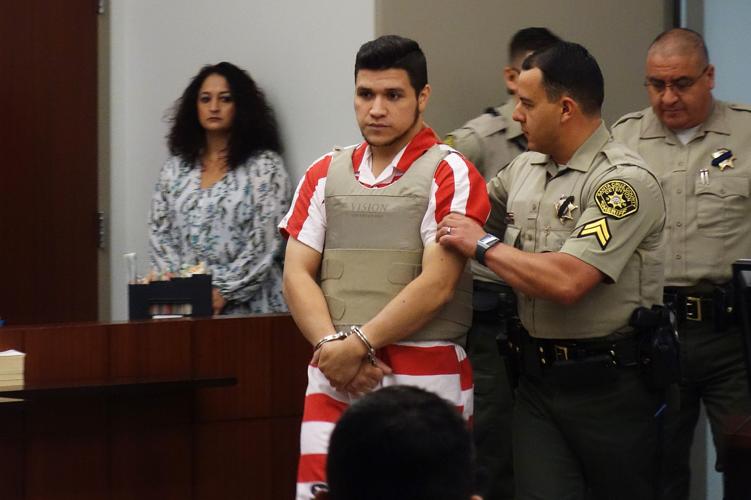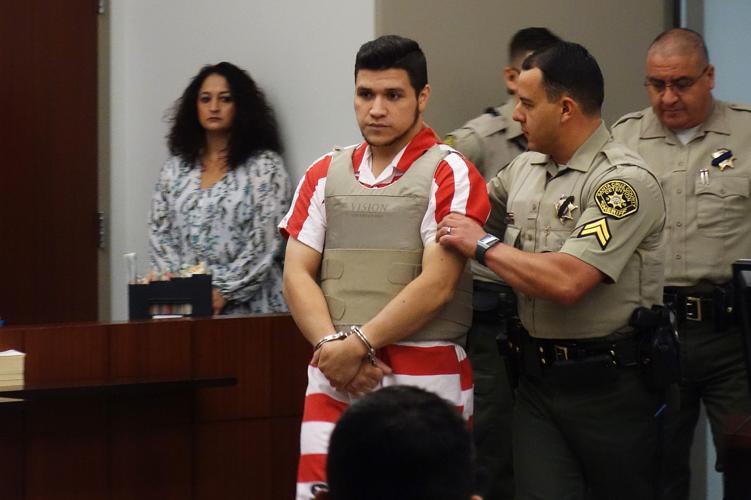
Examining a High-Profile Methamphetamine Case: A Closer Look at Legal and Enforcement Strategies
In recent weeks, a case from Nogales has caught the attention of legal experts and the general public alike. The sentencing of Sergio Humberto Ramos, a 73-year-old man from Nogales, for possessing methamphetamine with intent to distribute, not only highlights the challenges inherent in drug enforcement operations but also raises questions about how the legal system handles cases involving complicated pieces of organized crime and drug trafficking. This opinion editorial aims to dig into the case details, explore the multi-agency collaboration behind the investigation, and examine the twists and turns in legal strategies that come into play during such prosecutions.
At the heart of this case lies the operation led by the U.S. Attorney’s Office in Arizona, which worked closely with several other federal and state agencies. The case demonstrates the benefits of permanent, co-located task force initiatives that, by design, allow different law enforcement bodies to work side-by-side. In doing so, they not only share intelligence but also pool resources to tackle the tangled issues associated with drug-related offenses. In the process, however, some legal fine points and hidden complexities inevitably arise.
Case Background and Legal Proceedings
Sergio Humberto Ramos was sentenced to 120 months in federal prison followed by five years of supervised release. Ramos pleaded guilty to possessing methamphetamine with the intent to distribute, admitting that his role was to store the illegal substance at his trucking yard near Nogales until it could be transported. His actions, though perhaps seen as a cog in a much larger machine, underscore the nerve-racking and sometimes intimidating nature of drug distribution networks that stretch across local, state, and international boundaries.
The sentencing took place in the presence of Chief Judge Jennifer G. Zipps, and it marks an important moment in the ongoing struggle against drug trafficking in the southwestern United States. By issuing a firm sentence, the court sent a clear message regarding the consequences of becoming involved in the drug trade, even in roles that might seem peripheral. This decision reflects not only the importance of holding individuals accountable but also the goal of disrupting the entire network responsible for trafficking these substances.
Multi-Agency Collaboration: Working Through the Complex Landscape
One of the standout features of this case is the role played by multiple enforcement agencies. The investigation was led by the Organized Crime Drug Enforcement Task Forces (OCDETF), which include the Drug Enforcement Administration, Department of Homeland Security Investigations, U.S. Customs and Border Protection, along with local agencies like the Pima County Sheriff’s Department and the Arizona Department of Public Safety. Their shared approach allowed them to figure a path through the complicated pieces of the case, collaboration which is essential in modern law enforcement.
The permanent, co-located task force model they use has a key benefit: by pooling together resources, training, and intelligence, these agencies can collectively overcome the nerve-racking challenges of investigating and prosecuting drug-related crimes. The model proves that when multiple agencies take the wheel at the same location and work on intelligence-driven operations, the cumulative expertise often leads to breakthroughs in even the most tangled issues.
Key Strengths of Multi-Agency Cooperation
- Improved Intelligence Sharing: Enables real-time updates and more informed decision-making during investigations.
- Resource Consolidation: Maximizes the use of personnel, technical, and financial resources across different agencies.
- Coordinated Strategy: Helps teams plan and execute operations that target not just individual incidents but entire networks.
- Enhanced Communication: Fosters clear channels of dialogue, minimizing miscommunication and overlapping jurisdictional issues.
Each of these strengths contributes to a more streamlined and effective approach when working through the tricky parts of high-stakes operations. By maintaining an open line of communication and rigid coordination protocols, law enforcement can better tackle the subtle details and little distinctions that complicate criminal investigations.
Legal Implications of Methamphetamine Possession with Intent to Distribute
The legal framework surrounding drug offenses is replete with fine points that can make prosecutions either straightforward or full of problems, depending on the evidence and the circumstances of the case. Possessing methamphetamine with intent to distribute carries serious penalties, in part because it contributes to a larger ecosystem of organized crime where each actor, regardless of their role, is seen as a critical link in the chain.
By taking a closer look at Ramos’ case, we can see how the legal system deals with these types of charges. For prosecutors, establishing intent and linking the defendant to a broader distribution network are key elements. The evidence in this instance was sufficient to demonstrate that Ramos knowingly stored methamphetamine, with the understanding that it was meant for further distribution. This connection helps to justify the stringent sentence issued by the court.
Dissecting the Charges: A Closer Look at the Law
- Possession: The act of having controlled substances in one’s possession, which by itself is a serious crime under federal law.
- Intent to Distribute: Demonstrates a planned action of sharing, selling, or transporting controlled substances, increasing the weight of the crime.
- Evidence Gathering: In this case, Ramos admitted to storing the drugs at his facility, which was crucial evidence of his involvement.
- Sentencing Implications: The resulting sentence not only reflects the severity of the crime but also serves as a deterrent for similar actions by others.
It is critical to note that each element of the charge carries its own set of legal challenges. For instance, proving intent beyond a reasonable doubt often involves dissecting circumstantial evidence, testimonial accounts, and sometimes even digital records. This process can be nerve-racking, as each minute piece of evidence must be scrutinized and linked back to the defendant’s overall scheme.
Organized Crime Task Forces: Permanent Structures in a Changing Landscape
The case against Ramos falls under a broader initiative led by the Organized Crime Drug Enforcement Task Forces. These permanent, co-located agencies are designed to get around the shortfalls of jurisdictional constraints that sometimes leave law enforcement efforts fragmented and less effective. The task force model is a prime example of how modern law enforcement agencies are adapting to tougher legal and tactical challenges.
Permanent task forces have become indispensable for several reasons. Not only do they allow for a pooling of resources, but they also foster an environment where agencies can rapidly respond to emerging trends in drug trafficking. Whether it is tracking the movement of illegal shipments or understanding the subtle details that differentiate one network from another, these teams are well-equipped to handle the evolving dynamics of drug trade operations.
Advantages of the Co-Located Task Force Model
- Rapid Response: Being in the same location enhances the speed at which agencies can respond to emerging threats.
- Unified Command: Clarifies authority and operational procedures while minimizing jurisdictional disputes.
- Collaborative Analysis: Fosters a setting where multiple perspectives can come together to analyze evidence and strategize operations.
- Efficient Use of Resources: Prevents the duplication of efforts by ensuring that all participating agencies work in a streamlined fashion.
Overall, the task force model proves to be extremely beneficial for understanding and countering the organized crime networks that enable drug trafficking. It also serves as a reminder that when agencies work through their respective responsibilities in a coordinated way, the outcome is often a more effective disruption of criminal enterprises.
Understanding the Challenges of Tracking Organized Drug Trafficking Networks
Drug trafficking is a multifaceted problem, often loaded with issues that complicate both investigation and prosecution. Storing, transporting, and distributing controlled substances like methamphetamine involves a chain of events where each link is subject to legal analysis. The case under review sheds light on how even peripheral roles in a distribution network can lead to significant legal consequences.
Legal experts observe that even seemingly mundane tasks, such as storing goods in a trucking yard, carry a heavy burden when connected to larger criminal schemes. The challenge lies not only in proving the defendant’s involvement but also in addressing every little twist that could potentially undermine the case. As law enforcement agencies handle these operations, they must remain vigilant about the sometimes overwhelming and intimidating nature of dissecting such cases — ensuring that every subtle part and hidden complexity is thoroughly examined.
Essential Considerations for Prosecutors
- Gathering Concrete Evidence: Securing tangible proof that binds the accused to the crime without leaving room for ambiguity.
- Establishing a Clear Chain of Custody: Proving the path that the controlled substances took from point of possession to distribution.
- Linking Co-Conspirators: Demonstrating how individual actions contribute to a larger, organized network.
- Understanding the Broader Impact: Recognizing that even lower-level operations can have significant ripple effects on public health and safety.
By focusing on these aspects, prosecutors can effectively counter arguments that attempt to minimize the defendant’s culpability. The process might involve sampling evidence from multiple sources, conducting forensic analysis, and interviewing a range of witnesses to provide a complete picture of the drug trafficking operation.
Evaluating the Sentencing Decision: Deterrence and Rehabilitation
The sentence of 10 years in prison followed by five years of supervised release carries heavy implications. It reflects the judicial system’s commitment to deter similar actions, while also acknowledging the potential for rehabilitation. The decision to impose a lengthy sentence highlights the need for strict deterrence measures against engaging in drug trafficking, regardless of whether one is a major player or involved in a seemingly minor logistical role.
Critics sometimes argue that lengthy sentences can be intimidating and off-putting, particularly for roles that may not be directly tied to the most violent aspects of criminal networks. However, in cases like Ramos’, the legal system appears to view even peripheral involvement as a significant threat — not just to immediate community safety, but to the broader national security interests as well.
Components of a Sentencing Strategy
- Deterrence: A lengthy sentence acts as a stern warning to others who might consider engaging in similar activities.
- Accountability: Ensures that every actor within a criminal network is held responsible for their role, however small it may seem.
- Rehabilitation Prospects: The period of supervised release is critical for monitoring re-entry into society, ensuring that former offenders receive support as they attempt to make their way through reintegration.
- Community Impact: Reinforces public trust in the ability of the legal system to manage and resolve drug-related crimes efficiently.
It is clear that the decision to hand down a substantial sentence was intended to serve multiple functions. Not only does it enforce the consequences of participating in an organized drug trafficking operation, but it also helps to manage the nerve-wracking bits of public risk by sending a resolve that any engagement with such networks will be met with the full force of federal law.
Broader Lessons for the Criminal Justice System
Ramos’ case is not simply an isolated event — it represents a snapshot of the challenges facing a legal system that must continually adjust to evolving criminal methodologies. The delicate balance between individual accountability and broader systemic impacts is one that many legal professionals are constantly figuring out. Cases like this force us to get into discussions about how law enforcement can be more effective while still respecting the rights of the accused.
One of the main issues is how to manage your way through the maze of responsibilities and accountability when multiple agencies are involved. The successful coordination shown in this case point to a future where collaboration not only enhances efficiency but also improves the accuracy of investigations in complex, multi-jurisdictional environments. Despite the scary and overwhelming legal challenges, there is a clear path forward when agencies and the legal framework work in sync.
The Impact of Inter-Agency Communication on Public Safety
- Strengthened Partnerships: Establishing a network of trust among agencies is key to successful operations.
- Innovative Techniques: Collaborative setups frequently encourage the development of new strategies and solutions.
- Resource Optimization: Shared intelligence often leads to more efficient use of operational resources and legal expertise.
- Community Confidence: When agencies are visibly working together, it boosts public confidence in the ability of law enforcement to handle even the most formidable challenges.
The broader lesson here is one of optimism. Despite the many intimidating twists and turns that drug trafficking investigations can present, there are robust mechanisms in place that continuously refine how cases are handled. This model is not without its flaws, but its benefits — in terms of enhanced public safety and improved legal outcomes — are undeniable.
The Future of Drug Enforcement: Innovations and Legal Adaptations
As technology and criminal operations become increasingly sophisticated, so too must the legal strategies used to counter them. Cases similar to that of Sergio Humberto Ramos demonstrate that the fight against drug trafficking is an evolving battle. Law enforcement agencies are learning to manage the little twists of modern criminal enterprises by investing in new technologies, improving inter-agency communication, and rethinking traditional enforcement strategies.
Future efforts in drug enforcement will likely see an even tighter integration of digital forensics, data analytics, and real-time intelligence sharing. These innovations are expected to further refine the investigative process — allowing authorities to get around the convoluted bits of evidence and build stronger cases against those involved in organized crime networks. This evolution is a promising sign that legal systems are not standing still but are actively adapting to the shifting landscape of crime.
Emerging Trends in Law Enforcement Tactics
- Digital Forensics and Cyber Surveillance: Embracing technology to trace communication patterns and financial transactions linked to drug trafficking.
- Data-Driven Policing: Utilizing big data to predict and prevent criminal activity before it occurs.
- Collaborative Intelligence Platforms: Creating shared digital environments where multiple agencies can analyze evidence together in real time.
- Training and Development: Constantly updating the skill sets of law enforcement personnel to include new technological tools.
These trends herald a future where the legal system can more effectively dismantle the networks that enable drug trafficking. While the path forward is full of little twists and subtle details that can complicate efforts, it is a path that is both critical and promising when it comes to improving public safety and ensuring accountability.
Community Impact and the Importance of Transparency
One often overlooked aspect of cases like Ramos’ is the ripple effect they have on the community. The strict enforcement of drug laws has a dual effect: it helps to curb the spread of dangerous substances such as methamphetamine, while also reassuring the public that their safety is a top priority for law enforcement. Transparency and clear communication play a crucial role in ensuring that the community understands both the rationale and the benefits behind stringent sentencing measures.
Clear communication from agencies like the U.S. Attorney’s Office helps the public steer through the nerve-racking bits of legal proceedings and understand that such operations are designed not to target individuals in isolation, but to dismantle larger, organized networks that threaten community welfare. In doing so, it builds public trust, which is an essential component of effective law enforcement.
The Role of Public Information in Strengthening Community Trust
- Media Releases and Updates: Timely press releases keep the community informed about the progress of major cases.
- Social Media Outreach: Platforms like Twitter and X offer rapid channels for sharing detailed updates.
- Open Communication Channels: Ensuring that community members have access to clear, honest explanations of legal actions builds mutual trust.
- Educational Initiatives: Programs that inform the public about the broader context of drug enforcement and legal accountability help bridge the gap between law enforcement and community perceptions.
Ultimately, transparency in legal proceedings is a must-have element in modern law enforcement. It helps demystify the process and shows that every step — even those that might seem off-putting at first glance — is taken with the community’s best interests in mind.
Concluding Thoughts: Balancing Accountability and Reform
The case of Sergio Humberto Ramos serves as a powerful illustration of the many factors that come into play when tackling drug trafficking. It underscores the importance of coordinated law enforcement strategies, draws attention to the legal fine points that can complicate prosecutions, and raises critical questions about how best to balance strict accountability with avenues for reform.
There is no simple answer to the challenge of dismantling organized drug networks. Each case is loaded with issues that test both the resilience of legal institutions and the capacity for reform within the system. However, the coordinated approach seen in this case provides a valuable template for future actions. It shows that when agencies come together — pooling resources, sharing intelligence, and working through the tricky parts of complicated criminal operations — the outcomes can be both effective and just.
Looking forward, it is super important for legal and enforcement agencies to continue adapting to the ever-evolving strategies employed by drug traffickers. This includes investing in new technologies, enhancing cross-agency communication, and maintaining open channels with the communities they serve. While the path is sometimes overwhelming and filled with nerve-racking twists, every step taken towards a more collaborative and transparent system is a step in the right direction.
Key Takeaways for the Future
- Continued Collaboration: Multi-agency task forces will remain essential in effectively dismantling organized crime networks.
- Technological Advancements: Embracing innovation in digital forensics and data analysis will further enhance investigative capabilities.
- Community Engagement: Transparent and consistent communication with the public builds trust and reinforces the legitimacy of enforcement actions.
- Ongoing Legal Education: Training legal professionals and law enforcement officers in the subtle details of modern criminal behavior is crucial for future successes.
In conclusion, the case against Sergio Humberto Ramos is more than just an isolated incident—it is a mirror reflecting the evolving challenges and responses within the U.S. legal system regarding drug trafficking. While the legal road can be full of tangled issues and intimidating hurdles, the case underscores the importance of coordinated, transparent, and adaptive law enforcement strategies. As agencies continue to improve and innovate, there is hope that future operations will not only serve justice but also pave the way for a safer, more secure community.
Originally Post From https://www.justice.gov/usao-az/pr/nogales-man-sentenced-10-years-prison-possessing-intent-distribute-methamphetamine
Read more about this topic at
Methamphetamine Trafficking Offenses in the Federal …
Quick Facts on Federal Methamphetamine Trafficking …


